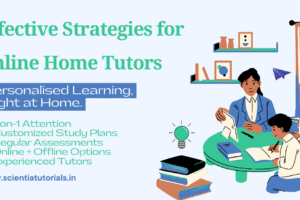Creative Strategies for Home Tutors: Engaging Students Through Dynamic Teaching Techniques
Introduction
Home tutoring presents unique opportunities for personalized learning and one-on-one instruction, yet it also comes with its challenges, especially when it comes to keeping students engaged. Without the social dynamics of a classroom, home tutors must find creative ways to spark curiosity, maintain attention, and foster a love for learning. The effectiveness of a tutor is often determined by their ability to connect with the student, adapt to their needs, and use innovative methods to make learning enjoyable. This article explores teaching tips for home tutors, focusing on creative techniques to engage students and enhance their learning experience.
1. Understanding the Student’s Learning Style
Before jumping into creative teaching methods, it’s essential to understand the student’s unique learning style. Every student absorbs information differently, and identifying their preferred way of learning will help tailor your techniques to engage them more effectively.
Key Learning Styles:
- Visual learners: Learn best through visual aids like diagrams, charts, and images.
- Auditory learners: Retain information better when it’s delivered through listening activities like lectures, discussions, and podcasts.
- Kinesthetic learners: Prefer hands-on activities and learn through doing, movement, and experimentation.
- Reading/Writing learners: Learn best through reading textbooks, writing notes, and organizing information in written form.
By identifying and catering to your student’s learning style, you can design lessons that play to their strengths and keep them more engaged.
2. Using Storytelling to Teach Concepts
One of the most powerful ways to engage students is through storytelling. Stories create a connection between abstract concepts and real-world applications, making lessons more relatable and memorable. Whether teaching literature, history, science, or even math, storytelling helps students better understand and retain information.
Creative Techniques:
- Turn lessons into stories: Instead of presenting dry facts, weave them into a narrative. For example, when teaching history, recount historical events as a story, emphasizing key characters and dramatic moments.
- Create characters: In subjects like math or science, invent characters that face problems the student must help solve. This can transform a challenging lesson into an engaging adventure.
- Use personal anecdotes: Relating the subject matter to your personal experiences or telling stories that the student can relate to helps make the material more engaging and less intimidating.
3. Incorporating Games and Gamification
Gamification is the process of applying game-design elements to educational activities to increase engagement and motivation. Turning learning into a game can transform an ordinary lesson into a fun, competitive, and rewarding experience.
Creative Techniques:
- Create educational games: Design quizzes, flashcard games, or math challenges that reward the student for correct answers. You can keep track of their progress with a score sheet or leaderboard.
- Introduce rewards and challenges: Implement a system of rewards for achievements. For example, after mastering a lesson or scoring well on a quiz, the student can earn points, which can be exchanged for small prizes or privileges.
- Use educational apps: There are many apps that gamify learning across different subjects. Tools like Kahoot!, Quizlet, or Duolingo can be integrated into tutoring sessions to add variety and fun.
Games make learning feel like play, which increases motivation and decreases anxiety associated with challenging subjects.
4. Utilizing Technology and Multimedia
The integration of technology into home tutoring allows tutors to access a wide range of tools that can enhance learning. Multimedia tools such as videos, podcasts, animations, and interactive apps cater to different learning styles and provide dynamic, engaging content.
Creative Techniques:
- Use educational videos: Platforms like YouTube and TED-Ed have a wealth of educational videos that break down complex topics into simple, visual explanations. These can be used to complement your lessons and provide different perspectives.
- Interactive websites and simulations: Websites like Khan Academy or PhET Interactive Simulations offer interactive content that allows students to explore subjects in depth.
- Create digital projects: Encourage students to create PowerPoint presentations, videos, or digital posters on topics they’ve learned. This not only reinforces learning but also gives them a sense of ownership and pride in their work.
Technology allows you to create lessons that are more interactive and appealing, making it easier for students to stay engaged.
5. Hands-On Activities and Real-World Applications
Many students find it easier to grasp concepts when they can see how they apply in the real world. Hands-on activities, experiments, and practical applications help students make connections between the material and everyday life, making learning more tangible and relevant.
Creative Techniques:
- Science experiments: For subjects like chemistry or physics, simple at-home experiments can turn abstract concepts into real, hands-on learning. These activities allow students to apply theories and witness results in real time.
- Field trips: Take the lesson outside the house by visiting places that relate to the subject matter, such as museums, historical sites, or science centers. These experiences can deepen the student’s understanding and make learning come alive.
- Project-based learning: Assign projects that require students to apply what they’ve learned in creative ways. For example, if you’re teaching economics, ask the student to create a mock business plan or budget.
Real-world applications make learning practical and relevant, which boosts engagement and interest in the subject matter.
6. Personalizing the Learning Experience
One of the most significant advantages of home tutoring is the ability to tailor lessons to the student’s individual needs and interests. Personalizing lessons not only keeps the student engaged but also builds a connection between the material and their passions.
Creative Techniques:
- Incorporate the student’s hobbies: If the student is passionate about sports, music, or art, try to integrate these interests into your lessons. For example, use sports statistics to teach math or analyze song lyrics in language lessons.
- Student-led sessions: Occasionally allow the student to take the lead in lessons. Let them choose a topic they’re interested in, research it, and teach it back to you. This boosts their confidence and reinforces their learning.
- Tailor materials to their level: Create custom worksheets, quizzes, and exercises based on the student’s progress. By offering personalized content, you’re showing the student that the lessons are designed with their success in mind.
Personalized learning ensures that lessons are more meaningful and relevant to the student, which helps maintain their interest and motivation.
7. Encouraging Active Participation and Discussion
Passive learning, where the tutor talks and the student listens, can quickly lead to disengagement. To keep students engaged, tutors should encourage active participation and foster a dialogue, transforming the lesson into a two-way conversation.
Creative Techniques:
- Ask open-ended questions: Encourage critical thinking by asking questions that require more than a yes-or-no answer. Ask the student to explain concepts in their own words or share their opinions on a topic.
- Debates and discussions: In subjects like history or literature, organize mini-debates or discussions where the student has to defend a position. This encourages them to think critically and engage more deeply with the material.
- Role-playing: In subjects like literature or social studies, have the student role-play historical figures or characters from a story. This creative activity helps them better understand the material while adding a fun element to the lesson.
Active participation increases the student’s engagement and ensures that they are fully involved in the learning process.
8. Breaking Up Lessons with Brain Breaks and Movement
Sitting in one place for an extended period can lead to fatigue and a loss of focus, especially for younger students. Incorporating short breaks and physical activities into your tutoring sessions can refresh the student’s mind and body, helping them stay engaged throughout the lesson.
Creative Techniques:
- Brain breaks: Include short, 5-10 minute breaks between lessons to give the student’s brain a rest. Use this time for simple activities like stretching, walking, or a quick puzzle.
- Movement-based learning: Incorporate physical movement into the lesson when possible. For example, ask the student to act out vocabulary words, solve math problems written on different sides of the room, or complete a scavenger hunt based on the lesson material.
- Relaxation techniques: Teach students simple mindfulness or breathing exercises to help them stay calm and focused during stressful or challenging parts of the lesson.
Incorporating movement and breaks keeps students mentally and physically refreshed, ensuring they stay focused and engaged.
Conclusion
Home tutoring offers unparalleled opportunities for individualized learning, but it also requires creativity and flexibility to maintain student engagement. By understanding the student’s learning style, incorporating storytelling, gamification, technology, and hands-on activities, tutors can create an engaging and dynamic learning environment. Personalizing lessons and encouraging active participation also keep students motivated and invested in their education. Through these creative strategies, home tutors can transform their sessions into a fun, productive, and impactful experience, helping students not only achieve academic success but also develop a lifelong love for learning.



